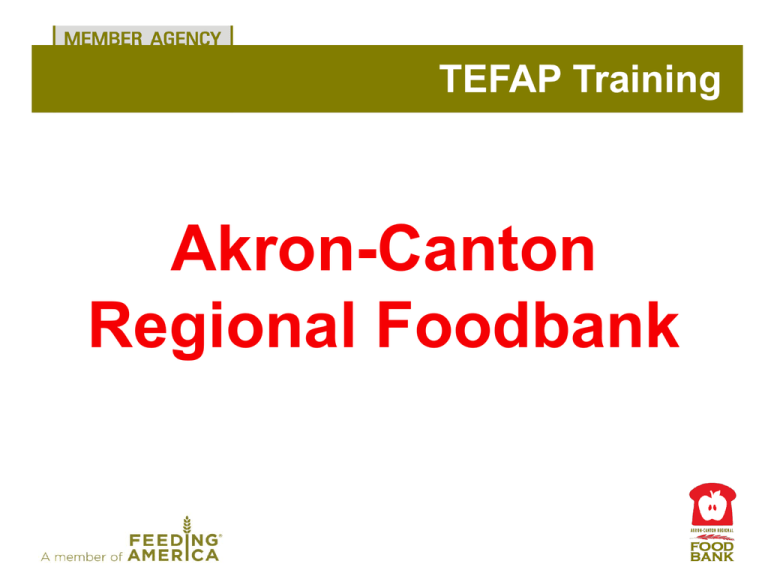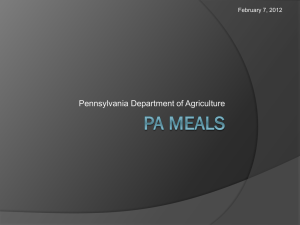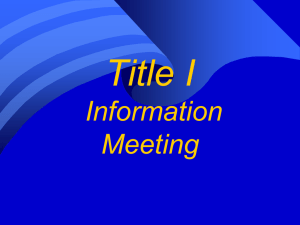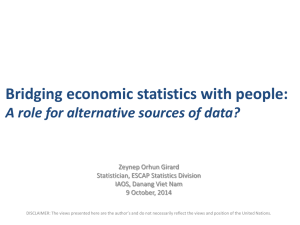
TEFAP Training
Akron-Canton
Regional Foodbank
Overview of Training
Training Summary
Overview of Training
•
•
•
•
•
•
•
What TEFAP is
Rules/Regulations
Distribution Guidelines
How to complete the Take Food Home Form
Proxy
Monthly Reports
Scenario's
TEFAP Overview
What is TEFAP?
What is TEFAP?
• TEFAP: The Emergency Food Assistance Program
• Federal program
– supplements the diets of low-income Americans
– includes elderly
• emergency food / nutrition assistance at no cost
How it works?
• U.S.D.A. supplies commodity foods to the States
• States provide food to local agencies
– usually to food banks
• distribute the food to hot meals and food
pantries that directly serve the public
How it works?
Requirements &
Guideline's
Requirements
1.) Post Household Eligibility Guidelines
2.) Confirm a valid I.D. for each applicant
3.) Complete the Take Food Home form
4.) All USDA/TEFAP forms completed by clients must be kept
for a minimum of 3 years.
* Completed forms are subject to review by Foodbank staff, food donors and
appropriate government agencies.
Requirements
5.) Be open a minimum of every 30 days
6.) And Justice for All poster must be visible to all clients
7.) Equality is the Law poster must be visible to all clients
8.) No altering or repackaging of any state or USDA product
Distribution Guidelines
Agencies:
• MUST allow clients access to food a minimum of once a month
• MUST post regular hours of operation and set procedures for
referral and/or on call access
• MUST post the USDA Income Guidelines for recipients where the
general public can see them
• MUST post USDA “And Justice For ALL” Civil Rights poster
where recipients can see
Distribution Guidelines
Agencies:
• MUST post USDA “And Justice For ALL” Civil Rights poster
where recipients can see
• Must complete a recipient’s self-declaration EACH TIME
they receive food assistance
• Must submit a monthly statistical report by the 10th of the
following:
–
–
–
–
–
the number of households with and without children
number of seniors 60+ with and without children
number of adults 18-59 with and without children
number of children under 18
total number of people served
Distribution Guidelines
Agencies:
• MUST NOT require proof of income. Recipients only need a selfdeclaration of eligibility. A copy of the current eligibility.
– Agency will NOT be held liable for ineligible recipients who receive a federal
food benefit by improperly self-declaring eligibility
• MUST NOT require a recipient’s social security number to receive
(violates Federal privacy acts)
• MUST NOT charge fees, NOR ask recipients for donations of any
type
• MUST NOT require recipients to be a member of any
organization or participate in any religious services
Distribution Guidelines
Agencies:
• MUST NOT require recipients to participate in any type of trainings
or consultations
• MUST NOT discriminate on the basis of race, color, religion,
national origin, sex, age or disability
• MUST NOT modify the self-declaration eligibility form
nor include additional information written or stapled to the form
• WILL NOT sell, exchange, use for personal gain or in any
fraudulent manner any USDA commodities or other products
obtained from the Foodbank
The TEFAP Form
TEFAP Form
Ohio Department of Job and Family Services
This box is optional for local
agency use, check one:
A (Household with minor children)
B (Household without minor children)
FEDERAL AND STATE FUNDED FOOD PROGRAMS
ELIGIBILITY TO TAKE FOOD HOME
Name
Address
City
Zip
Area Code + Phone
(
Number of people in household by age: age 60+
)
age 18 - 59
age birth - 17
Total
This table shows yearly gross income for each family size. If your household income is at or below the income listed for the number of people in your household,
you are eligible to receive food.
This certification form is being completed in connection with the distribution of food from the state funded program and/or
Federal assistance through The Emergency Food Assistance Program.
Household Size
1
2
3
4
5
6
7
8
9
For each additional person
add
Yearly
Income
$22,979
$31,019
$39,059
$47,099
$55,139
$63,179
$71,219
$79,259
$87,299
$8,040
Monthly
Income
$1,914
$2,584
$3,254
$3,924
$4,594
$5,264
$5,934
$6,604
$7,274
$670
Weekly
Income
$441
$596
$751
$905
$1,060
$1,214
$1,369
$1,524
$1,678
Read the following statement carefully, then sign the form & write in today’s date.
I certify that my current gross household income is at or below the income
listed on this form for households with the same number of people as my
household.
I also certify that, as of today, my household lives in the area
served by this agency. Program officials may verify what I have certified to be
true. I understand that making a false certification may result in having to pay
the State for the value of the food improperly issued to me and may subject me
to criminal prosecution under State and Federal law.
Signature
Date
X
X
$155
The U.S. Department of Agriculture prohibits discrimination against its customers, employees, and applicants for employment on the bases of
race, color, national origin, age, disability, sex, gender identity, religion, reprisal, and where applicable, political beliefs, marital status, familial or
parental status, sexual orientation, or all or part of an individual’s income is derived from any public assistance program, or protected genetic
information in employment or in any program or activity conducted or funded by the Department.
(Not all prohibited bases will apply to all
programs and/or employment activities.)
If you wish to file a Civil Rights program complaint of discrimination, complete the USDA Program
Discrimination Complaint Form, found online at http://www.ascr.usda.gov/complaint_filing_cust.html, or at any USDA office, or call (866) 632-9992
to request the form. You may also write a letter containing all of the information requested in the form. Send your completed complaint form or
letter to us by mail at U.S. Department of Agriculture, Director, Office of Adjudication, 1400 Independence Avenue, S.W., Washington, D.C. 202509410, by fax (202)690-7442 or email at program.intake@usda.gov. Individuals who are deaf, hard of hearing or have speech disabilities may contact
USDA through the Federal Relay Service at (800) 877-8339; or (800) 845-6136 (Spanish). USDA is an equal opportunity provider and employer.
This box is optional for local
agency use, check one:
Full Service
Partial Service
Full Service
Partial Service
Full Service
Partial Service
Full Service
Full Service
Full Service
Full Service
Full Service
Full Service
Full Service
Full Service
Partial Service
Partial Service
Partial Service
Partial Service
Partial Service
Partial Service
Partial Service
Partial Service
Effective July 1, 2013
Signature
Date
X
X
Signature
Date
X
X
Signature
Date
X
X
Signature
Date
X
X
Signature
Date
X
X
Signature
Date
X
X
Signature
Date
X
X
Signature
Date
X
X
Signature
Date
X
X
Signature
Date
X
X
Signature
Date
X
X
Completing the TEFAP Form
•
Name, address, phone number
•
Number of people living in their household by age
group
•
No other information is required
•
Agencies are not allowed to ask for social security
numbers or proof of income
Completing the TEFAP Form
• First and last names are required
– (last name first, first name last is allowed)
• Complete street address with apartment, unit or lot
number
• Spell out city names in full. Not abbreviated
• If the client does not know their zip code, place a
zero (0) or N/A in the slot
Completing the TEFAP Form
• Include area codes with phone numbers
• If the client does not have a phone, write no phone
or N/A in that field
• All age fields must be completed and the total field
must be completed
• If there is no one in the household for a particular
age range, place a zero (0) or a dash(--) in that field
Completed Form
Sarah Doe
123 Apple Rd.
Cuyahoga Falls
44223
1
330-555-9876
1
Sarah Doe
Sarah Doe
3
5
7/8/2010
8/28/2010
TEFAP Form Practice
Practice Form
Practice Form
Practice Form
Practice Form
Client Intake
•
•
•
•
•
•
•
Name: Anna Sthesia, 46
Address: 2468 Sugarcreek Rd
City: Akron
Zip: 44305
Phone: 330.777.7777
Current Date: 3/15/2013
Additional people in household:
– Sara, 48
– Greg, 13
– Joe, 16
– Keith, 6
Practice Form
Anna Sthesia
2468 Sugar Creek Rd.
Akron
44305
0
330-777-777
2
Anna Sthesia
3
5
3/15/2013
Client Intake
•
•
•
•
•
•
•
Name: Cliff Hanger, 27
Address: 1265 Cleveland Ave NW
City: Canton
Zip: 44722
Phone: 330.555.5513
Current Date: 3/30/2013
Additional people in household:
– Jennifer, 30
– Katie, 12
– Kevin, 18
– Jacob, 3
Practice Form
Cliff Hanger
1265 Cleveland Ave. NW
Canton
44722
0
330-555-5513
3
Cliff Hanger
2
5
3/30/2013
Client Intake
•
•
•
•
•
•
•
Name: Robin Banks, 63
Address: 8823 Nold Ave.
City: Wooster
Zip: 44691
Phone: 330.222.2311
Current Date: 4/1/2013
Additional people in household:
– Amber, 3
– Jerry, 4
– Cole 5
Practice Form
Robin Banks
8823 Nold Ave.
Wooster
44691
1
330-222-2311
0
Robin Banks
3
4
4/1/2013
TEFAP Form
TEFAP PRACTICE
Find the mistake
TEFAP Form: Proxy
The Proxy Process
Example Proxy Letter
TEFAP Form: Proxy
• Proxy: a person authorized to act for another
• Proxy must have a signed letter from the client receiving food
stating they are picking up food on their behalf
• Proxy must sign his/her name on the client form - NOT the
clients name
• Client (or proxy) enters signature and date. If the client cannot
write his or her own name place an X in the signature field
and the pantry worker or volunteer initials that the client
cannot sign their name
TEFAP Form, Proxy Cont’d
• Forms must be completed in ink so they cannot be altered
• The proxy form cannot be stapled to the TEFAP form
• The letter can be paper clipped and should be kept on file
• Have client come in once a year in July to update form
• Must call client one additional time throughout the year to
ensure they are receiving Foodbank product
The Monthly Report
Monthly Reporting
Monthly Reporting
• Statistical reports are required every month and are not
contingent on where your food comes from or the number of
clients served.
• Monthly reports must be submitted even if you did not use
Foodbank product and even if the number of clients served for
the given month is zero.
Monthly Reporting
• Monthly Reports are due by the 10th of each month for the
previous month’s distribution.
• For example, a January Monthly Report would be due
February 10, and a February Monthly Report would be
due March 10. There are no exceptions to this policy.
• Agencies must keep copies of Monthly Reports for three
years.
Monthly Reporting by Sections
The Monthly Report is broken down into five basic sections.
Depending on your type of agency and feeding program it may not be
necessary to complete each section.
• The first section – All member agencies must complete this
section of the Monthly Report. This section requests basic
information about your agency name and the name of the person
completing the report in case there are questions.
Monthly Reporting by Sections
• The second section – Food Pantries or agencies with Food
Pantry Programs.
Monthly Reporting by Sections
• The third section – Meal Sites open to the public and Shelters.
Monthly Reporting by Sections
• The fourth section – Agencies that provide food as a
supplement to their programs, such as group homes, drug and
alcohol rehabilitation or youth recreation program.
• These types of programs are called Congregate and Residential
Programs.
Monthly Reporting by Sections
• The last section – Any member agency wishing to provide
additional information or to provide clarity on the reported numbers.
• If the you need an immediate response or attention to your written
comment, please call your Member Services Representative.
The Monthly Report
Monthly Reporting
Exercise
Scenarios
Scenarios
• No Identification/Drivers License
• Outside of my service Territory/From
Cleveland, OH
• Client refused to sign TEFAP form
• Household Composition Changes
• Client has had a birthday/change in age on
household composition
Scenarios
•
•
•
•
•
Child comes to live with you for the summer
Fraud Suspicion
Makes too much money
Husband and Wife on the same form
Must be 18 or older/Letter of Emancipation
TEFAP Training
TRUE OR FALSE?
True or False
Each client receiving food must
complete the TEFAP form with first and
last name, address, including zip code,
phone number and number of people
living in their household by age group.
True or False
All food pantry programs and direct
distributions are required to post household
Income Eligibility Guidelines and use the
Federal and State Funded Food Programs
Eligibility to Take Food Home form as part of
federal and state compliance?
True or False
All TEFAP forms completed by clients
must be kept for a minimum of 2 years.
True or False
The form can not be altered in any way
shape or form.
True or False
The TEFAP form must be signed and
dated EVERY time a client receives food.
True or False
Agency representatives can write
additional information on the back of the
TEFAP form.
True or False
Agencies are allowed to ask for social
security numbers and proof of income, such
as a paystub or financial statements.
True or False
You can staple a proxy to the TEFAP
form?
True or False
You should write the clients drivers license
and SS# on the TEFAP form?
TEFAP Training
Best Practices
Best Practices
• Form Storage Retention
• Notebook storage
• Color coded TEFAP forms
• Volunteer written forms
Best Practices
• Typed and Printed
• PantryTrak
• Additional Participant Suggestions
Review
Summary – what we covered
•
•
•
•
•
•
What TEFAP is
Rules/Regulations
Distribution Guidelines
How to complete the Take Food Home Form
Proxy
Monthly Reports
TEFAP Training
Any Questions?









